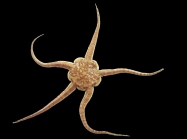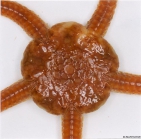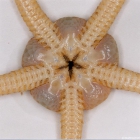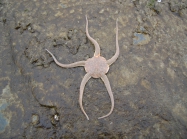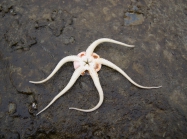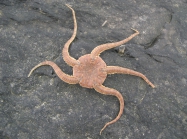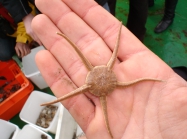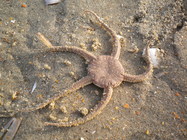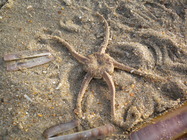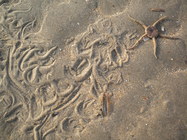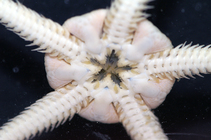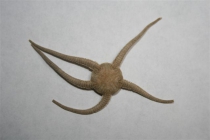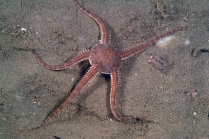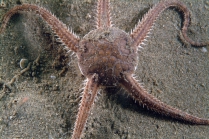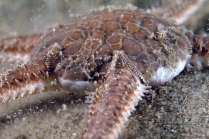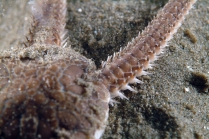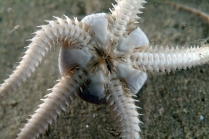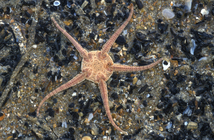Scheldt species taxon details
Ophiura ophiura (Linnaeus, 1758)
124929 (urn:lsid:marinespecies.org:taxname:124929)
accepted
Species
marine, brackish, fresh, terrestrial
(of ) Linnaeus, C. (1758). Systema Naturae per regna tria naturae, secundum classes, ordines, genera, species, cum characteribus, differentiis, synonymis, locis. [The system of nature through the three kingdoms of nature, according to classes, orders, genera, species, with characters, differences, synonyms, places.]. <em>Impensis Direct. Laurentii Salvii. Holmiae [Stockholm].</em> 1(10) [iii], 824 p., available online at https://biodiversitylibrary.org/page/726886 [details] Available for editors 
Stöhr, S.; O’Hara, T.; Thuy, B. (Eds) (2021). World Ophiuroidea Database. Ophiura ophiura (Linnaeus, 1758). Accessed through: VLIZ Consortium Scheldt Species Register at: https://scheldemonitor.nl/speciesregister/aphia.php?p=taxdetails&id=124929 on 2025-09-11
VLIZ Consortium. Scheldt Species Register. Ophiura ophiura (Linnaeus, 1758). Accessed at: https://www.scheldemonitor.be/speciesregister/aphia.php?p=taxdetails&id=124929 on 2025-09-11
original description
(of ) Linnaeus, C. (1758). Systema Naturae per regna tria naturae, secundum classes, ordines, genera, species, cum characteribus, differentiis, synonymis, locis. [The system of nature through the three kingdoms of nature, according to classes, orders, genera, species, with characters, differences, synonyms, places.]. <em>Impensis Direct. Laurentii Salvii. Holmiae [Stockholm].</em> 1(10) [iii], 824 p., available online at https://biodiversitylibrary.org/page/726886 [details] Available for editors 
context source (Schelde) Goudswaard, K.; van Asch, M. (2015). Kuilen op de Westerschelde: data rapport 2015. <em>IMARES Wageningen Report, C145/15. IMARES Wageningen UR: Yerseke.</em> 14 pp. (look up in IMIS) [details]
context source (BeRMS 2020) Flanders Marine Institute (VLIZ); (2013). Data collected during the expeditions of the e-learning projects Expedition Zeeleeuw and Planet Ocean. [details]
basis of record Hansson, H.G. (2001). Echinodermata, <B><I>in</I></B>: Costello, M.J. <i>et al.</i> (Ed.) (2001). <i>European register of marine species: a check-list of the marine species in Europe and a bibliography of guides to their identification. Collection Patrimoines Naturels,</i>. 50: pp. 336-351. (look up in IMIS) [details]
additional source Southward, E.C.; Campbell, A.C. (2006). [Echinoderms: keys and notes for the identification of British species]. <i>Synopses of the British fauna (new series)</i>, 56. Field Studies Council: Shrewsbury, UK. ISBN 1-85153-269-2. 272 pp. (look up in IMIS) [details]
additional source Muller, Y. (2004). Faune et flore du littoral du Nord, du Pas-de-Calais et de la Belgique: inventaire. [Coastal fauna and flora of the Nord, Pas-de-Calais and Belgium: inventory]. <em>Commission Régionale de Biologie Région Nord Pas-de-Calais: France.</em> 307 pp., available online at http://www.vliz.be/imisdocs/publications/145561.pdf [details]
additional source Hansson, H. G. (1998). NEAT (North East Atlantic Taxa): Scandinavian Echinodermata Check-List (Comp.). , available online at https://www.gu.se/sites/default/files/2020-10/NEAT%2AEchinodermata.pdf [details]
context source (Schelde) Goudswaard, K.; van Asch, M. (2015). Kuilen op de Westerschelde: data rapport 2015. <em>IMARES Wageningen Report, C145/15. IMARES Wageningen UR: Yerseke.</em> 14 pp. (look up in IMIS) [details]
context source (BeRMS 2020) Flanders Marine Institute (VLIZ); (2013). Data collected during the expeditions of the e-learning projects Expedition Zeeleeuw and Planet Ocean. [details]
basis of record Hansson, H.G. (2001). Echinodermata, <B><I>in</I></B>: Costello, M.J. <i>et al.</i> (Ed.) (2001). <i>European register of marine species: a check-list of the marine species in Europe and a bibliography of guides to their identification. Collection Patrimoines Naturels,</i>. 50: pp. 336-351. (look up in IMIS) [details]
additional source Southward, E.C.; Campbell, A.C. (2006). [Echinoderms: keys and notes for the identification of British species]. <i>Synopses of the British fauna (new series)</i>, 56. Field Studies Council: Shrewsbury, UK. ISBN 1-85153-269-2. 272 pp. (look up in IMIS) [details]
additional source Muller, Y. (2004). Faune et flore du littoral du Nord, du Pas-de-Calais et de la Belgique: inventaire. [Coastal fauna and flora of the Nord, Pas-de-Calais and Belgium: inventory]. <em>Commission Régionale de Biologie Région Nord Pas-de-Calais: France.</em> 307 pp., available online at http://www.vliz.be/imisdocs/publications/145561.pdf [details]
additional source Hansson, H. G. (1998). NEAT (North East Atlantic Taxa): Scandinavian Echinodermata Check-List (Comp.). , available online at https://www.gu.se/sites/default/files/2020-10/NEAT%2AEchinodermata.pdf [details]
 Present
Present  Inaccurate
Inaccurate  Introduced: alien
Introduced: alien  Containing type locality
Containing type locality
Encyclopedia of Marine Life of Britain and Ireland
Marine Life Information Network - UK
To Barcode of Life (56 barcodes)
To Biodiversity Heritage Library (8 publications)
To Dyntaxa
To European Nucleotide Archive, ENA (Ophiura ophiura)
To GenBank (8084 nucleotides; 32 proteins)
To Global Biotic Interactions (GloBI)
To PESI
To USNM Invertebrate Zoology Echinodermata Collection (5 records)
To ITIS
Marine Life Information Network - UK
To Barcode of Life (56 barcodes)
To Biodiversity Heritage Library (8 publications)
To Dyntaxa
To European Nucleotide Archive, ENA (Ophiura ophiura)
To GenBank (8084 nucleotides; 32 proteins)
To Global Biotic Interactions (GloBI)
To PESI
To USNM Invertebrate Zoology Echinodermata Collection (5 records)
To ITIS
